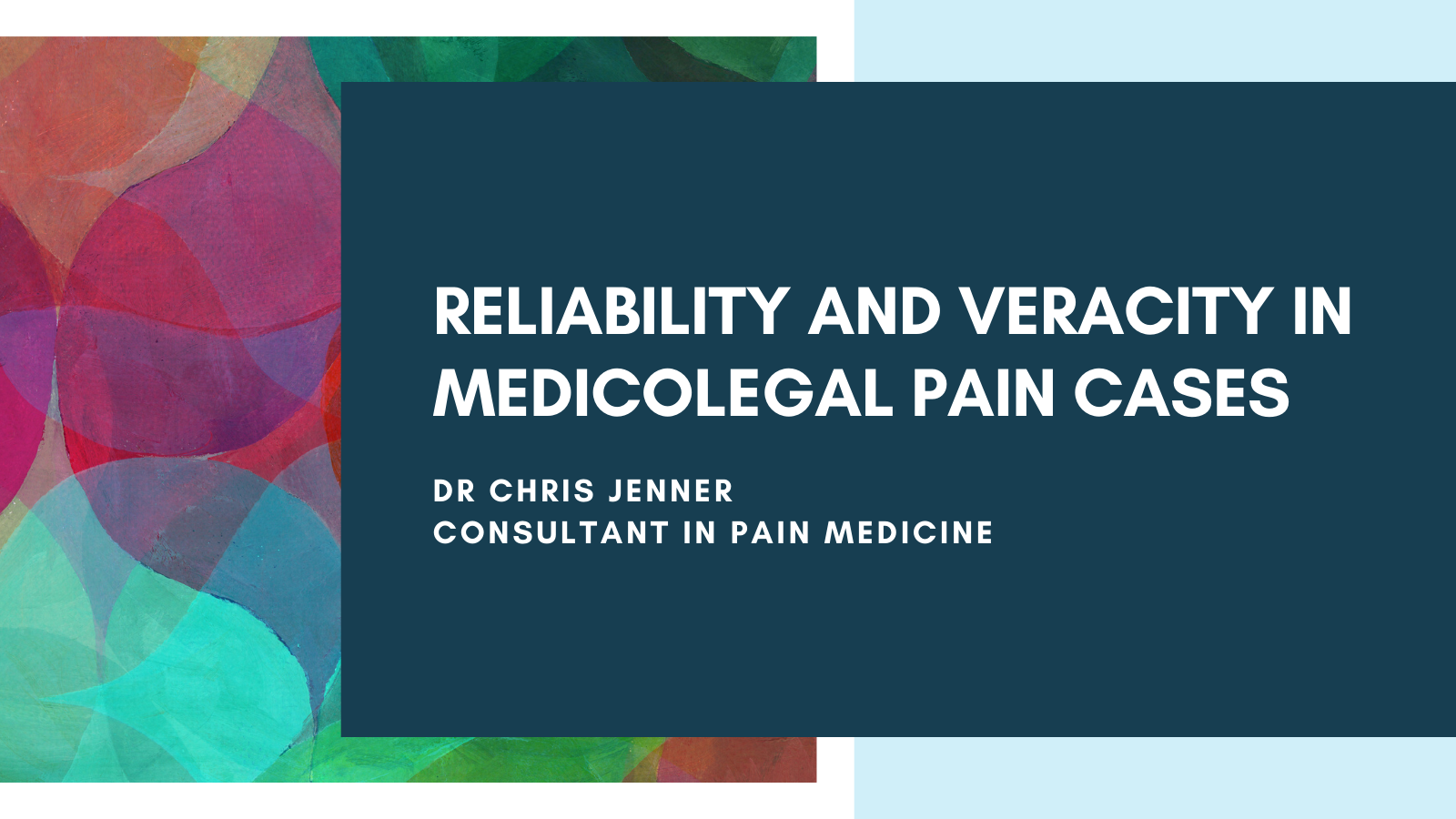Reliability and Veracity in Medicolegal Pain Cases

An accurate and reliable assessment of the patient’s condition is crucial in achieving a fair outcome in medicolegal cases involving chronic pain. While assessment of acute pain is relatively straightforward, measurement of chronic pain, and the effect it has on the patient’s day-to-day life, is more difficult. Pain assessment is particularly challenging in patients who cannot communicate well, such as those suffering from cognitive impairment or dementia. Pain is not just a sensory experience but also contains an emotional element. Therefore, the experience of pain is different for each individual and can be influenced by many factors, including the patient’s previous experiences of pain, expectations surrounding treatment and judgement by others, and cultural stigma. This means that objective assessment is not possible and all assessments of pain must rely on self-report by the patient.
In an attempt to improve the reliability of pain reporting, numerous instruments have been developed to measure pain, although the fact that so many exist indicates that assessment remains a challenge. These instruments aim to measure qualitative aspects of chronic pain and the impact it has on the patient’s function in a way that is valid, reliable and easy to use. For example, the Brief Pain Inventory aims to reflect the fact that the intensity of chronic pain varies throughout the day and night by asking the patient to rate their pain currently, as well as at its worst, least and average during the previous 24 hours. A screening questionnaire recently developed by the Norwegian Pain Society goes further, by including items on coping and catastrophising, health-related quality of life, the economic impact of the patient’s condition, their social security status and their involvement in any ongoing compensation or legal processes.
One drawback with pain assessment instruments is that reporting and interpretation of numerical pain ratings can be influenced by a combination of factors. The reasons for reporting pain depend upon the individual’s current motivations and context, as well as their experience of pain. As a result, despite established validity, the results of self-reported patient questionnaires are often queried. Both clinicians and lay people have a tendency to believe that patients are experiencing less pain than they are reporting, particularly in cases where compensation is being sought. It is difficult to estimate the prevalence of overreporting or exaggeration of symptoms, but it is notable that for fibromyalgia (FM), the reported rates of disability are much higher than those associated with other similar chronic illnesses. The reported rates of conditions such as whiplash are also much lower in countries where monetary compensation is rare. While this suggests that some patients may be overestimating the amount of pain they are in, more recent evidence shows that rates of malingering are actually low in patients with FM. Furthermore, compensation rarely results in the resolution of symptoms.
While research has shown that many patients do admit to overreporting their pain, the motivation for this is rarely monetary gain. Instead, many patients say that they are in more pain than is actually the case to ensure that they are taken seriously by their healthcare provider and receive proper treatment. This behaviour stems from a distrust in the healthcare system or the individual doctor, although a perceived likelihood of discrimination may also be a factor. Patients also overreport their pain when they are genuinely seeking support, as opposed to attention, from friends and family members.
Some patients report changing their pain ratings in response to fluctuations in the amount of pain they experience. If symptoms vary day-by-day, or even during one 24-hour period, there may be a tendency to give an average rating which is higher, to reflect the rating during periods when the pain is worse. Ratings may also change over the course of an illness; earlier scores may be higher as patients lack experience in rating pain and do not have a true grasp of the extremes of the pain scale.
While overreporting pain may occur for numerous reasons, research has shown that patients are equally likely to underreport pain. The main reasons for this appear to be a desire to avoid being given a potentially distressing diagnosis and the avoidance of medical settings and treatment. Judgement from others, particularly the widespread belief that pain is a weakness, is also an important driver of pain underreporting, reflecting the cultural stigma that exists around pain.
Interestingly, many people state that they never modulate their pain ratings, due to trust in their healthcare provider, a wish for accurate and appropriate treatment and for reasons of personal honesty. There is a cultural assumption that patients automatically overreport their pain, often for monetary gain, but this evidence suggests that overreporting is not as frequent as has previously been assumed.
Due to its subjectivity, adequate assessment of pain will remain a challenge. Various questionnaires are available that allow patients to rate the pain level they are experiencing. While over- and underreporting of pain is an issue, recognition that many patients do report honestly may help to decrease the negative assumptions about patient motives that exist within both the healthcare and legal systems.
About our Pain Expert
His particular areas of expertise include, but are not limited to:
- Neuropathic pain
- Chronic and chronic widespread pain
- Chronic Pain Syndromes
- Complex Regional Pain Syndrome
- Phantom limb pain and Post Mastectomy Pain Syndrome
- Multi-disciplinary pain management
- Fibromyalgia
Further reading:
Boring, B. L., Walsh, K. T., Nanavaty, N., Ng, B. W., & Mathur, V. A. (2021). How and Why Patient Concerns Influence Pain Reporting: A Qualitative Analysis of Personal Accounts and Perceptions of Others’ Use of Numerical Pain Scales. Frontiers in psychology, 12, 663890. https://doi.org/10.3389/fpsyg.2021.663890
Breivik, H., Borchgrevink, P. C., Allen, S. M., Rosseland, L. A., Romundstad, L., Hals, E. K., Kvarstein, G., & Stubhaug, A. (2008). Assessment of pain. British journal of anaesthesia, 101(1), 17–24. https://doi.org/10.1093/bja/aen103




